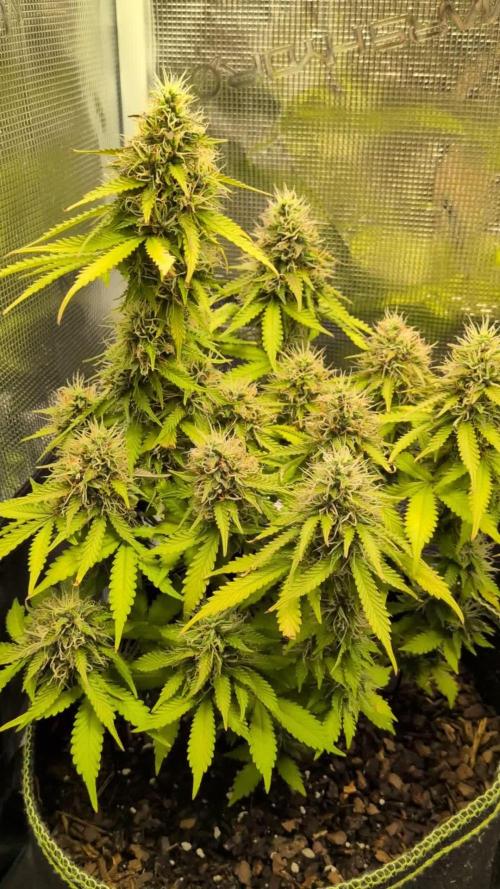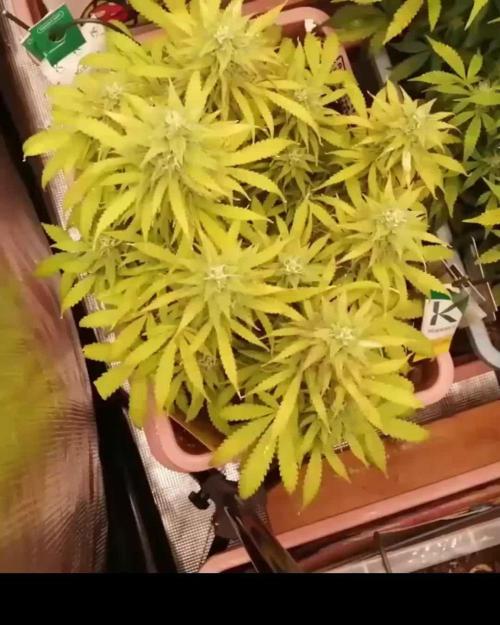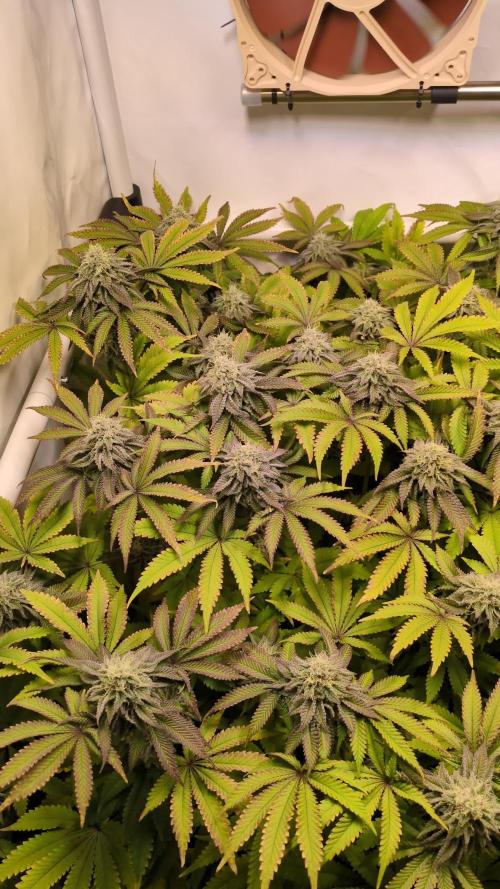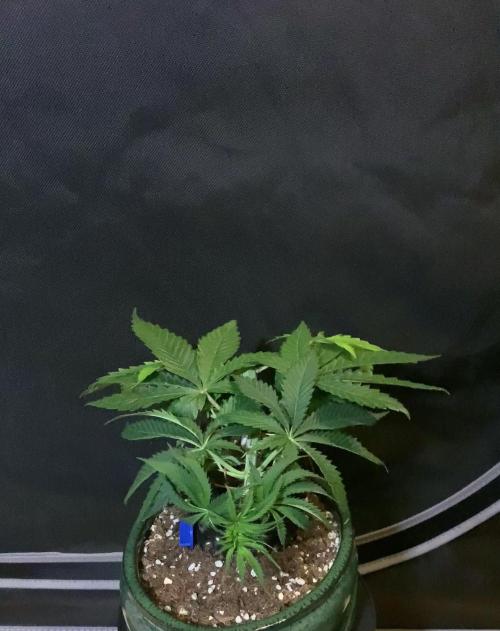The Grow Awards 2026 🏆 































Likes
Comments
Share


@therealgrowmie
Follow
Things are progressing with this grow.
The nutritional issues caused by recent heat stress may have stunted growth a bit, but the buds are forming nicely regardless.
They’ve started to bulk up, and now it’s just a matter of waiting for the final growth and ripening to finish. A lot of the pistils are still white, so we’re likely at least two weeks away from harvest.
Until next week, Growmies!
---
Quick rundown on everything else:
Watering: 1500ml every third day
Fertilizer: According to the BioBizz schedule
Light intensity: ~1000 PPFD
VPD: ~1.62 kPa
Temperature: ~28°C
Relative humidity: ~55%
Likes
11
Share


@Turbo420
Follow
Germinated seed directly in finishing pot (3 gallon fabric), with fox farm ocean forest as my medium.
Likes
2
Share


@MNGROW
Follow
She went from being the smallest to being the second tallest in just about 2 weeks she has been stretching real nice and looks like she is gonna start to bud.
Starting to get lots of bud
Likes
13
Share


@All_our_small_plants
Follow
2000 ml alle 2 Tage
pH-Wert: 6,1
EC-Wert: 1,2
Temperatur: 22ºC
Luftfeuchtigkeit 62%
Schädlingsbekämpfung:
PPFD: 500 µmol/m²/s
DLI: 33
Düngemittel: Mineralischer Dünger 3.5-6-6 PK 13/14
Besonderheiten: Wurden direkt in die erde gepflanzt in einer Kokos-Quelltabletten.
-Tag 65 Heute haben wir ihr wieder Wasser und Mikroorganismen gegeben. Wir haben sie auch wieder stark entlaubt damit die luft besser zirkulieren kann und sich kein Schimmel bildet.
-Tag 67 Heute haben wir sie mit 2000 ml Wasser gegossen, versetzt mit 1,5 ml Calmag, 5 ml Canna PK 13/14, 1 ml Plagron Green Sensation und 1 ml Plagron Power Buds. Der EC-Wert lag bei 1.460 mS/cm und der pH-Wert bei 6,2. 👽
-Tag 69 Heute haben wir sie mit 2000 ml Wasser gegossen, angereichert mit 1,5 ml Calmag, 6,5 ml Canna PK 13/14, 1 ml HY-PRO Epic Blast sowie 0,32 ml HY-PRO Generator. Der EC-Wert betrug 1,480 mS/cm und der pH-Wert lag bei 6,2. 😎
Likes
6
Share


@Ninjabuds
Follow
My 2 permanent marker plants they are loving the light being turned up they are praying constantly there internodes are so close together they have not stretched out very far yet. I'm thinking they are going to be on the short end but who knows some plants do complete opposite when they hit the flower strech. I still have not gotten the nutrients down for the one plant I'm thinking when I flip to flower it will it will turn around nicely I love the shaoe and look of it's leaves.
The day has come and it's time to flip these ladies to flower. I was planning on letting them go untill Friday and let the smaller ones grow just a bit more but they will be fine. I have the eternity cup contest in mind and I'm thinking timing so I need to get these lady done and out my tent lol. This past week I turned the light up alot getting them ready to flower they have grown a bunch inhavendone lst maybe 5 it 6 times on the branchs and they arw nit bendy anymore that will help durring flower.
Likes
15
Share


@IsseyBukkake
Follow
Week 2 has gone just as well as I'd like it too!
I had an accident during the week where I had dropped a sticky bug trap on one of my girls, this led to me accidentally ripping off a fan leaf and a half, but she seems to have come out of it just fine! (Thankfully).
I have been feeding 1/3 strength nutes the past few feeds, stepping it up from 1/4.
I will be watering until I see runoff from now on to prevent nutrients from building up in the coco.
Update(day 15, 4/12/20)
Today I purchased a new oscillating fan, co2 bags and a new hygrometer that hooks up to my phone and shows me stats.
The girls have been putting in a lot of work over the past 24 hours.
I also had a Purple Punch photo seed sprout today which I may be turning into a mother plant. I will be starting a diary for this girl too.
Update (Day 16 5/12/20)
Second purple punch photo popped today, going to keep 1 inside and give the other to my mom to take care of.
The girls got their first 1/4 dose of calmag today fed at 6ph due to all the nutrients settling there.( I do have ph +/- but I'm going to try run this whole grow at 5.8-6.2.
Update (Day 17 6/12/20)
Plants seem happy today.
Fan leaves producing a the pre-existing nodes are starting to shoot out quite rapidly.
Unfortunately, my streets power went out today for ~90 minutes, I opened the tent, windows and doors to get any light in I could, thankfully the power came back on shortly after.
I fed the girls today with very little run-off(I'm trying to perfect the amount of water they need).
Update (Day 18 7/12/20)
The girls have jumped up over night!
I wont be feeding today as I'd like the coco to dry out quite a bit more.
Update (Day 19 8/12/20
Gave the girls a small feed today with very little run-off
Everything seems to be going well so far, I'm very thankful!
Update (day 20 9/12/20)
Everything is going pretty well today.
I will not be feeding as the increased humidity has kept the coco more moist than usual.
Will be feeding full strength nutes tomorrow!
Thanks for stopping by, HMU with any questions or tips you have.
Likes
13
Share


@humblecrumble
Follow
Had lots of rain lately but she is still getting sun on most days. I keep her underneath the eave of my garage when it’s raining. Want to build a mini u dome type greenhouse soon to protect from the rain. Pruned her a bit because she was getting so bushy to get more light to all the colas. I think maybe 3 to 4 more weeks till she’s ready. Starting to smell really good too:)
Likes
33
Share


@NuggetPawn
Follow
More calm this week, not a lot of people mention on here that the work load reduces a couple weeks after the big stretch. Not had to do too much except a little bending as she’s still getting a bit too close to the lights again.
Most of the fan leaves are off now, that I can reach that is.
No more reservoir changes now until it gets the chop, as my nutrients stay fairly consistent for the next 3-5 weeks. At around 950 TDS @ 0.5 or 1900 PPM.
Still no nutrient deficiencies, the longest stretch I have gone without at least some spots or marks on leaves.
Would be interested to know what you guys think she might yield now she’s just about into her 5th week of flower?
Likes
2
Share


@Saintvicious
Follow
Flower stretch and bud sites are setting. Lots of tops from the lst. Fingers crossed.
Likes
9
Share


@Chucklebrother1
Follow
This is where I'm at so far with them 5weeks into flower, they've had lst plus supercropping (I'm still not too sure about this so didn't do a lot of it) and at week 3 of flower I stripped both plants of all their large fan leaves they looked pretty bare but seems to have done the job
Likes
6
Share


@tantrumrage
Follow
15/12 - 21/12: just waiting for the bulk. I've decided to stop adjusting the pH of my tap water and let the soil do the rest, maybe it was counter productive.
Now we wait ⏳
Likes
29
Share


@Greenthumbguru
Follow
shes plumpiing up real nice prolly give her another week then start flushing i can tell trimming gone suck 😂😂😂 if I had a better watt light she'd be denser
Likes
27
Share


@I_Identify_As_A_Dan
Follow
Week 1 of flower for Kalini Asia by Zamnesia seeds
Fed her 2.7g of BioBloom per L of soil, watered that in and flipped it to flower 24hours ago.
As more room opens up in the tent ill spread her out a little more.
Also not going to go crazy defoliating.
Likes
65
Share


@3lementa1
Follow
August 23: Just finishing up about 36 hours of darkness, then I'm going to wash the buds, then hang them. Harvesting a bit early due to time constraints but it looks good. The smell is very dank, not a tropical skittles smell, much more like wood glue as I've seen mentioned in other reviews, although I'm starting to occasionally catch a sweeter tropical scent as well.
I wanted to leave it a little longer. There were still a lot of white hairs when I started the dark period, but a lot of them seem to have developed into swollen calyxes so I'm pretty happy. I was a little worried they were making seed pods after last time, but I broke one open and all that was inside was red hairs. I'm going to keep an eye on the RH while they're drying and get them into jars and try to wait as long as possible before I start sampling. I can tell this is one of those batches that's going to get better and better if left alone for a couple months.
Just did the wash, did 1.25 cups of 34% food grade H202 and a squeezed lemon in a 5 gal bucket. Another bucket of just water to rinse. Then I had a fan on it while hanging in the sunlight from a skylight in the bathroom for 30 min, then put the fan further back and on oscillate, then turned it down an hour later. Left it in there for a few hours, then hung it in the grow tent with everything removed except an oscillating fan, pointed away from the buds. I have the whole plant hanging in the middle of the tent and the tent is holding at 60% rh.
Next run I'm going to do 2 buckets and only top once. I might leave them a bit longer in veg too to maximize the height in my grow space, and I'll get a proper 500w bulb instead of continuing to run 1000w bulbs at 50% to lower the heat a bit. The weather will be cooler and I'll only run one air stone in each bucket which should help with res temp. I'll probably foil-wrap the buckets again as well. I should be able to get another run done by the end of the year. I have a White Widow fem seed I've been waiting to use but I'm not sure what else I want to grow yet. Maybe Granddaddy Purp.
I'll take some micro pics of the trichomes this week and start curing, and I'll post a proper review in a couple weeks.
Happy growing everyone!
August 24: I took it out of the tent to inspect. No mold or mildew. The middle of some buds are still pretty wet. I'll keep an eye on it. Wet weight on the stem is 158 grams/ 5.5oz.
I harvested a couple branches last week and hung them up. I just ground up one of the buds, left it overnight and vaped some today. There was a bit of Chemdawg Tangerine in the grinder already but overall I got a lot of thick vapour, instant effects, and a really great tropical taste.
I busted out the microscope camera and I realized I had a couple buds that fell off before I washed the plant in the H202, and a couple buds that came off in the washing process. It doesn't look like washing the buds took off any of the trichomes. I do seem to find less debris in the buds, not that there was much there before. The trichs look great. Just a light toasting of amber. The washed bud actually seems more dry than the unwashed bud.
August 25: there's a real chlorophyll smell coming from the drying room today, it was much terpier yesterday. Leaves are getting crunchy, stems are still fully bendy. I ended up taking it down in the evening. The drying room rh dropped from 60% to 55% and the buds were starting to look too dry based on my last grow. I put it all in a paper bag for the night and I'll put it in jars tomorrow morning. Broken down most of the way it came out to 48-49 grams. From the bud structure, I definitely feel like it would have benefitted from more grow time if I didn't have to travel. More to come.
August 26 - the edges of the buds are getting really crispy and the buds are getting tighter. I checked the paper bag earlier and it was 65-70%. I got the impression it was time to put it into jars. I'll keep the lids off for a bit.
Likes
4
Share


@tsf_homegrow
Follow
🇩🇪
14.12. neue Woche neues Aussehen :) zwei Sonnensegel die nach oben zeigten entfernt, damit die inzwischen 4 seitentriebe etwas licht bekommen. die Drähte die letzten Tage über immer mal wieder neu justiert. Und vor ein paar Tagen zwei „Anker“ an den Stamm gesetzt damit die Pflanze bleibt wo sie ist. Durch den zug auf der anderen Seite hat sie angefangen sich dort mehr rüberzubiegen. Ansonsten macht sie sich ganz gut es läuft mehr oder weniger nach Plan.
Happy Growing💛✌️
🇬🇧
12.14. New week, new look :) I removed two upward-facing fan leaves so the four side shoots could get some light. I've been readjusting the wires a few times over the last couple of days. And a few days ago, I added two "anchors" to the stem to keep the plant in place. The tension on the other side had caused it to start bending more. Otherwise, it's doing quite well; things are more or less going according to plan.
Happy Growing💛✌️
Likes
12
Share


@Northstar_cannabis
Follow
11/17 started the flush until harvest. Plain tap well water, ph of well water is 7.3- 7.6
Pistols are orange and shrinking. Sugar leaves have a beautiful red on the edges and almost a red hue to the buds. It's a large yield plant for sure, large dense buds. Lives up to the name pound cake!
























